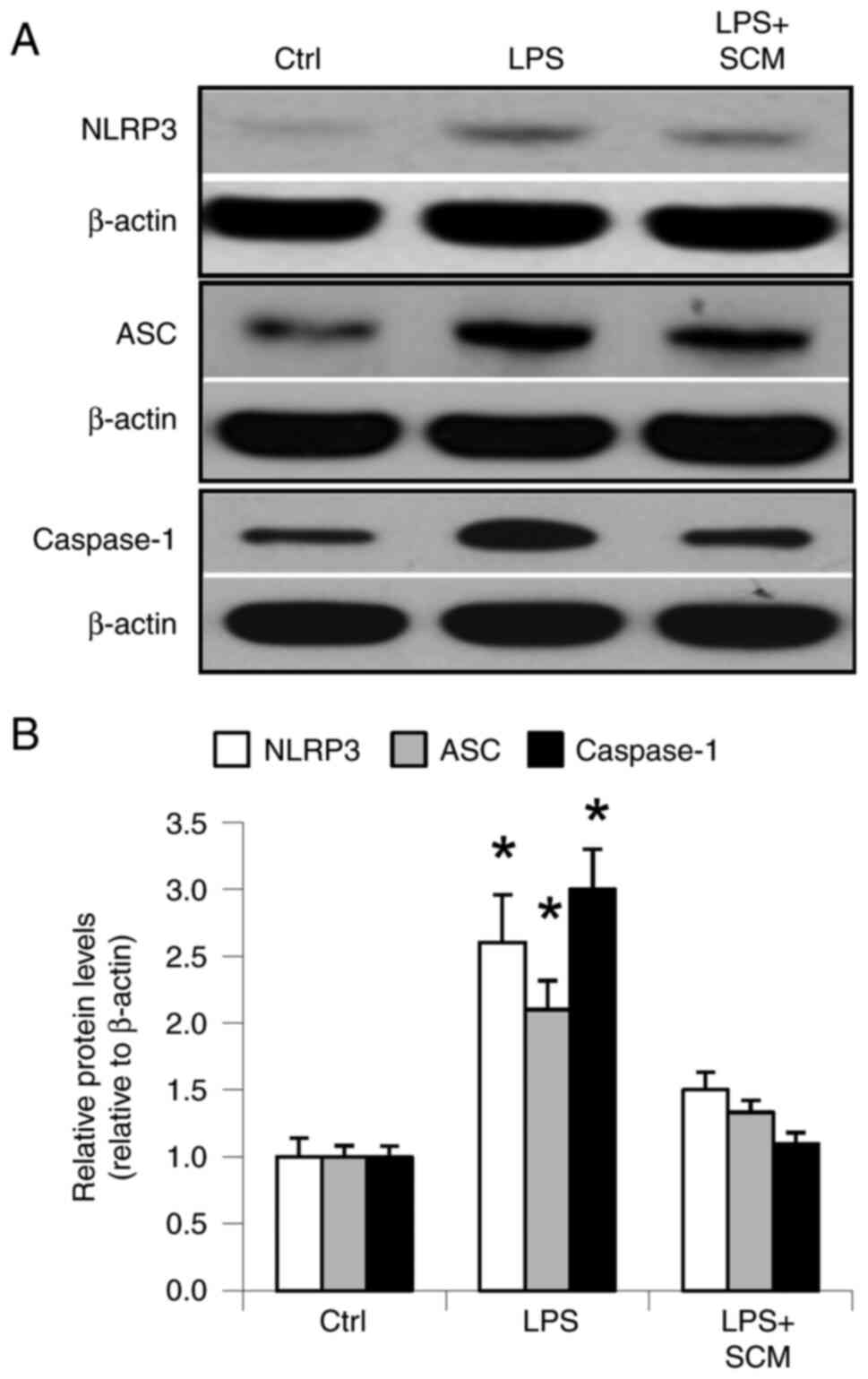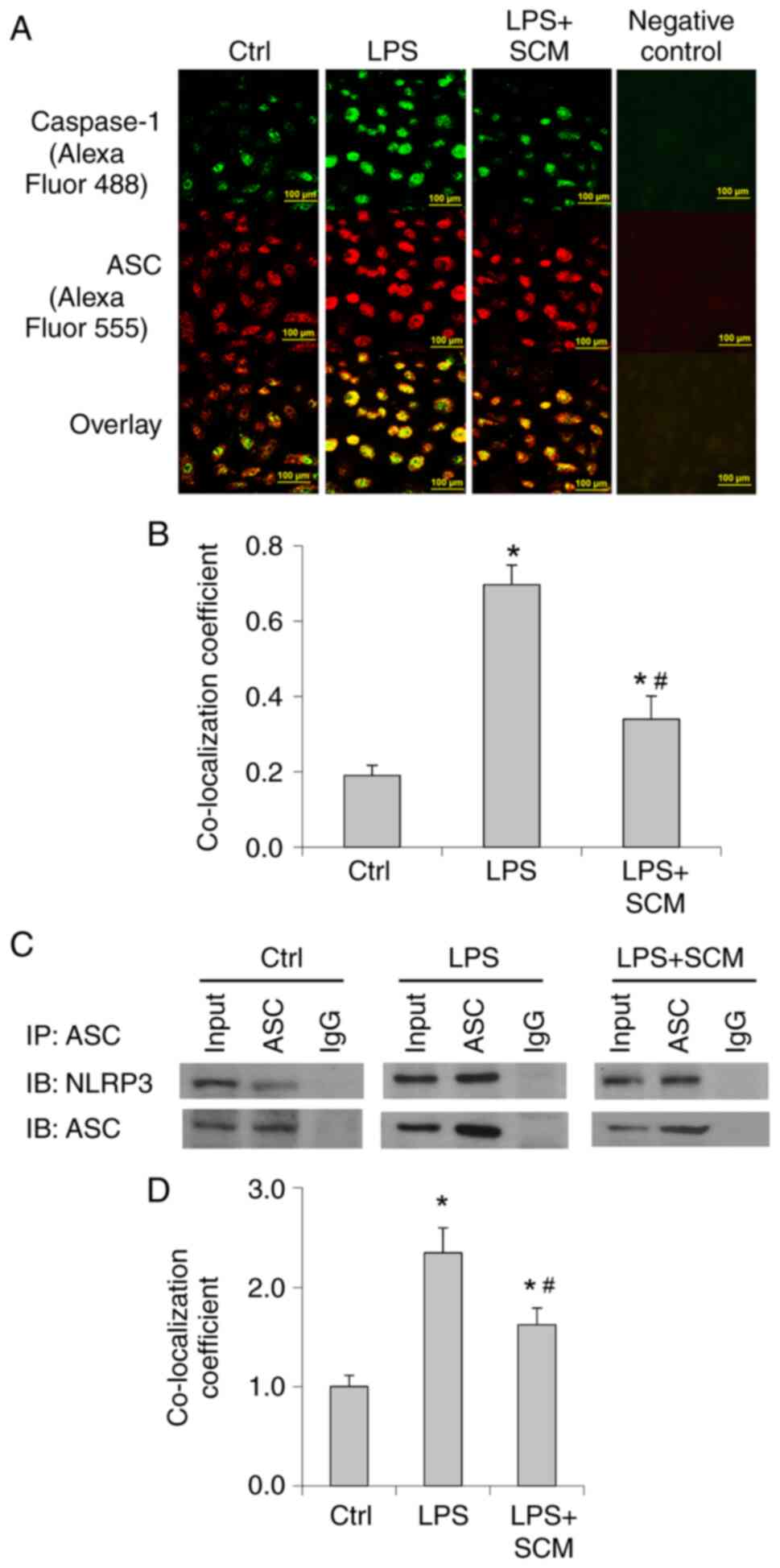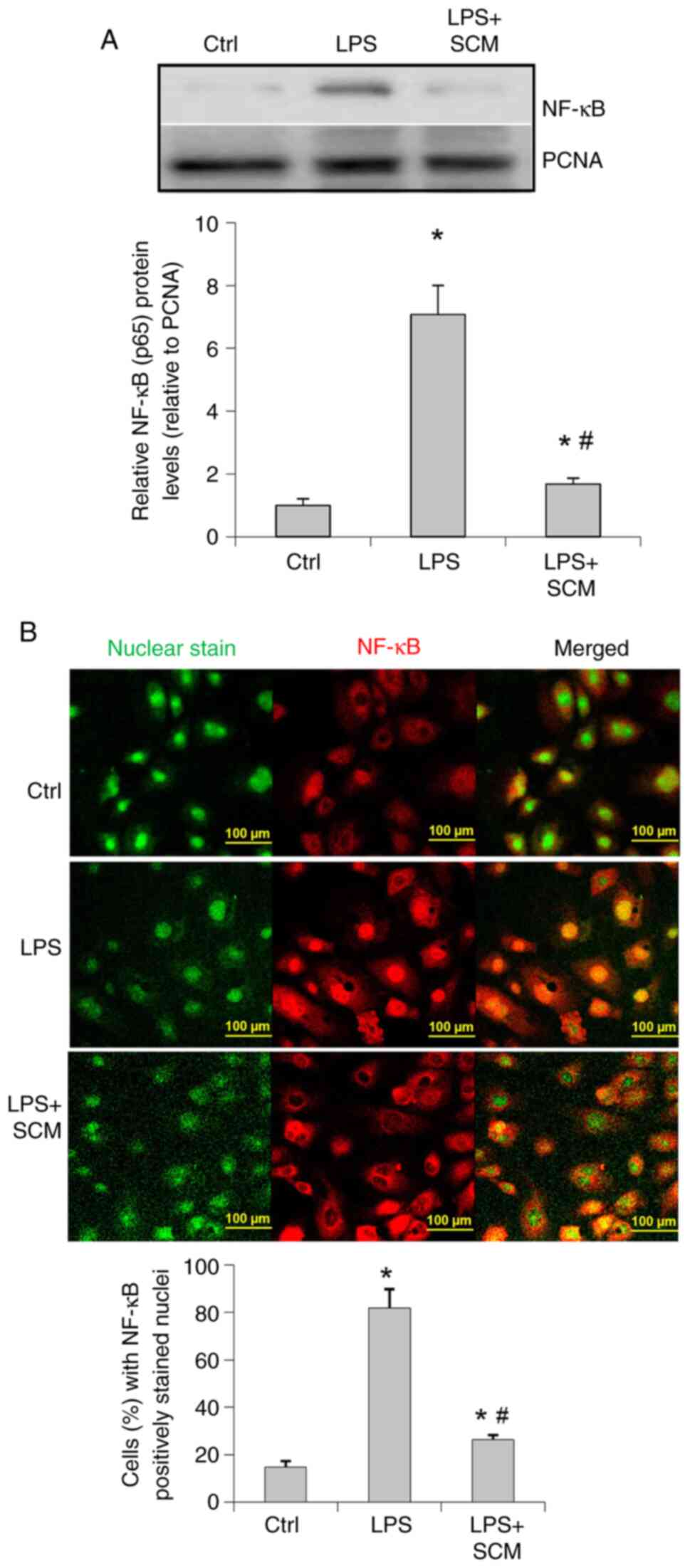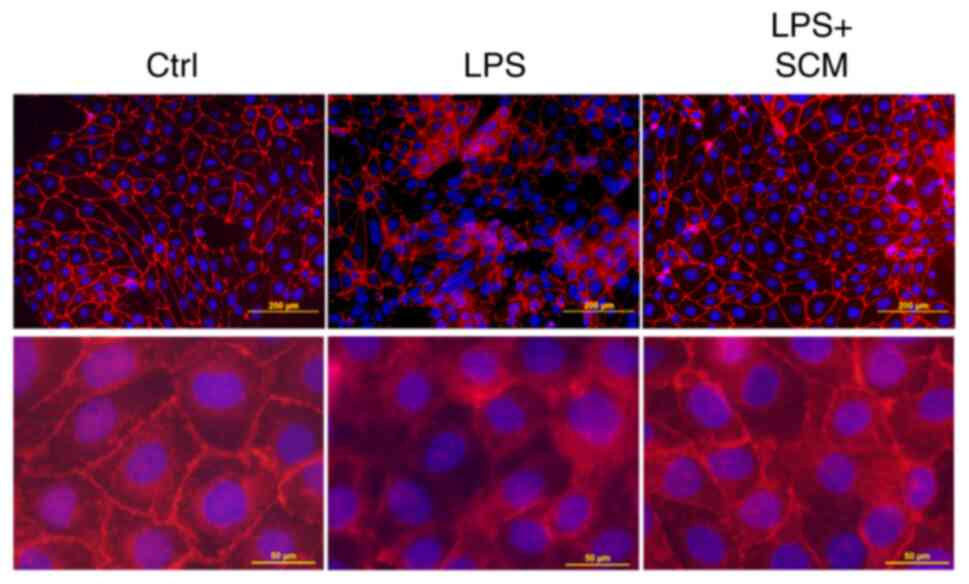|
1
|
Nazir MA: Prevalence of periodontal
disease, its association with systemic diseases and prevention. Int
J Health Sci (Qassim). 11:72–80. 2017.PubMed/NCBI
|
|
2
|
Bascones A, Noronha S, Gomez M, Mota P,
Moles MA and Dorrego MV: Tissue destruction in periodontitis:
Bacteria or cytokines fault? Quintessence Int. 36:299–306.
2005.PubMed/NCBI
|
|
3
|
Orozco A, Gemmell E, Bickel M and Seymour
GJ: Interleukin-1beta, interleukin-12 and interleukin-18 levels in
gingival fluid and serum of patients with gingivitis and
periodontitis. Oral Microbiol Immunol. 21:256–260. 2006. View Article : Google Scholar : PubMed/NCBI
|
|
4
|
Pedra JH, Cassel SL and Sutterwala FS:
Sensing pathogens and danger signals by the inflammasome. Curr Opin
Immunol. 21:10–16. 2009. View Article : Google Scholar : PubMed/NCBI
|
|
5
|
Schroder K and Tschopp J: The
inflammasomes. Cell. 140:821–832. 2010. View Article : Google Scholar : PubMed/NCBI
|
|
6
|
Broz P and Monack DM: Molecular mechanisms
of inflammasome activation during microbial infections. Immunol
Rev. 243:174–190. 2011. View Article : Google Scholar : PubMed/NCBI
|
|
7
|
Bostanci N, Emingil G, Saygan B, Turkoglu
O, Atilla G, Curtis MA and Belibasakis GN: Expression and
regulation of the NALP3 inflammasome complex in periodontal
diseases. Clin Exp Immunol. 157:415–422. 2009. View Article : Google Scholar : PubMed/NCBI
|
|
8
|
Park E, Na HS, Song YR, Shin SY, Kim YM
and Chung J: Activation of NLRP3 and AIM2 inflammasomes by
Porphyromonas gingivalis infection. Infect Immun. 82:112–123. 2014.
View Article : Google Scholar : PubMed/NCBI
|
|
9
|
Picciolo G, Mannino F, Irrera N, Minutoli
L, Altavilla D, Vaccaro M, Oteri G, Squadrito F and Pallio G:
Reduction of oxidative stress blunts the NLRP3 inflammatory cascade
in LPS stimulated human gingival fibroblasts and oral mucosal
epithelial cells. Biomed Pharmacother. 146:1125252022. View Article : Google Scholar : PubMed/NCBI
|
|
10
|
Huang X, Yang X, Ni J, Xie B, Liu Y, Xuan
D and Zhang J: Hyperglucose contributes to periodontitis:
Involvement of the NLRP3 pathway by engaging the innate immunity of
oral gingival epithelium. J Periodontol. 86:327–335. 2015.
View Article : Google Scholar : PubMed/NCBI
|
|
11
|
Yilmaz O: The chronicles of porphyromonas
gingivalis: The microbium, the human oral epithelium and their
interplay. Microbiology (Reading). 154:2897–2903. 2008. View Article : Google Scholar : PubMed/NCBI
|
|
12
|
Larijani B, Esfahani EN, Amini P, Nikbin
B, Alimoghaddam K, Amiri S, Malekzadeh R, Yazdi NM, Ghodsi M,
Dowlati Y, et al: Stem cell therapy in treatment of different
diseases. Acta Med Iran. 50:79–96. 2012.PubMed/NCBI
|
|
13
|
Malliaras K and Marban E: Cardiac cell
therapy: Where we've been, where we are, and where we should be
headed. Br Med Bull. 98:161–185. 2011. View Article : Google Scholar : PubMed/NCBI
|
|
14
|
Souidi N, Stolk M and Seifert M:
Ischemia-reperfusion injury: Beneficial effects of mesenchymal
stromal cells. Curr Opin Organ Transplant. 18:34–43. 2013.
View Article : Google Scholar : PubMed/NCBI
|
|
15
|
Bi B, Schmitt R, Israilova M, Nishio H and
Cantley LG: Stromal cells protect against acute tubular injury via
an endocrine effect. J Am Soc Nephrol. 18:2486–2496. 2007.
View Article : Google Scholar : PubMed/NCBI
|
|
16
|
Mariani E and Facchini A: Clinical
applications and biosafety of human adult mesenchymal stem cells.
Curr Pharm Des. 18:1821–1845. 2012. View Article : Google Scholar : PubMed/NCBI
|
|
17
|
Ionescu L, Byrne RN, van Haaften T,
Vadivel A, Alphonse RS, Rey-Parra GJ, Weissmann G, Hall A, Eaton F
and Thébaud B: Stem cell conditioned medium improves acute lung
injury in mice: In vivo evidence for stem cell paracrine action. Am
J Physiol Lung Cell Mol Physiol. 303:L967–L977. 2012. View Article : Google Scholar : PubMed/NCBI
|
|
18
|
Walter MN, Wright KT, Fuller HR, MacNeil S
and Johnson WE: Mesenchymal stem cell-conditioned medium
accelerates skin wound healing: An in vitro study of fibroblast and
keratinocyte scratch assays. Exp Cell Res. 316:1271–1281. 2010.
View Article : Google Scholar : PubMed/NCBI
|
|
19
|
Nguyen BK, Maltais S, Perrault LP, Tanguay
JF, Tardif JC, Stevens LM, Borie M, Harel F, Mansour S and Noiseux
N: Improved function and myocardial repair of infarcted heart by
intracoronary injection of mesenchymal stem cell-derived growth
factors. J Cardiovasc Transl Res. 3:547–558. 2010. View Article : Google Scholar : PubMed/NCBI
|
|
20
|
Lee JW, Fang X, Gupta N, Serikov V and
Matthay MA: Allogeneic human mesenchymal stem cells for treatment
of E. coli endotoxin-induced acute lung injury in the ex vivo
perfused human lung. Proc Natl Acad Sci USA. 106:16357–16362. 2009.
View Article : Google Scholar : PubMed/NCBI
|
|
21
|
Lepperdinger G, Brunauer R, Jamnig A,
Laschober G and Kassem M: Controversial issue: Is it safe to employ
mesenchymal stem cells in cell-based therapies? Exp Gerontol.
43:1018–1023. 2008. View Article : Google Scholar : PubMed/NCBI
|
|
22
|
Hua KF, Chou JC, Lam Y, Tasi YL, Chen A,
Ka SM, Fang Z, Liu ML, Yang FL, Yang YL, et al: Polyenylpyrrole
derivatives inhibit NLRP3 inflammasome activation and inflammatory
mediator expression by reducing reactive oxygen species production
and mitogen-activated protein kinase activation. PLoS One.
8:e767542013. View Article : Google Scholar : PubMed/NCBI
|
|
23
|
Yilmaz O, Sater AA, Yao L, Koutouzis T,
Pettengill M and Ojcius DM: ATP-dependent activation of an
inflammasome in primary gingival epithelial cells infected by
Porphyromonas gingivalis. Cell Microbiol. 12:188–198. 2010.
View Article : Google Scholar : PubMed/NCBI
|
|
24
|
Kamo N, Ke B, Ghaffari AA, Shen XD,
Busuttil RW, Cheng G and Kupiec-Weglinski JW: ASC/caspase-1/IL-1β
signaling triggers inflammatory responses by promoting HMGB1
induction in liver ischemia/reperfusion injury. Hepatology.
58:351–362. 2013. View Article : Google Scholar : PubMed/NCBI
|
|
25
|
Li H, Zhou X and Zhang J: Induction of
heme oxygenase-1 attenuates lipopolysaccharide-induced inflammasome
activation in human gingival epithelial cells. Int J Mol Med.
34:1039–1044. 2014. View Article : Google Scholar : PubMed/NCBI
|
|
26
|
SHEN H, ZHANG D and LIU H: Mesenchymal
stem cell conditioned medium azacytidine, panobinostat and GSK126
alleviate TGF-β-induced EMT in lung cancer. Food Sci Technol.
42:530212021. View Article : Google Scholar
|
|
27
|
Wang L, Li Y, Zhang X, Liu N, Shen S, Sun
S, Jiang Y, Li P, Jin H and Shen L: Paracrine interleukin-8 affects
mesenchymal stem cells through the Akt pathway and enhances human
umbilical vein endothelial cell proliferation and migration. Biosci
Rep. 41:BSR202101982021. View Article : Google Scholar : PubMed/NCBI
|
|
28
|
Zhang J, Gao Y, Chen P, Zhou Y, Guo S,
Wang L and Chen J: Bone marrow-derived mesenchymal stem cells
(BMSCs)-exosome carrying MiRNA-312 inhibits sevoflurane-induced
cardiomyocyte apoptosis through activation of phosphatidylinositol
3-Kinase/Protein Kinase B (PI3K/AKT) pathway. J Biomaterials Tissue
Engineering. 12:947–952. 2022. View Article : Google Scholar
|
|
29
|
Yu F, Wu F, Li F, Liao X, Wang Y, Li X,
Wang C, Shi Y and Ye L: Wnt7b-induced Sox11 functions enhance
self-renewal and osteogenic commitment of bone marrow mesenchymal
stem cells. Stem Cells. 38:1020–1033. 2020. View Article : Google Scholar : PubMed/NCBI
|
|
30
|
Liu MH, Bian BSJ, Cui X, Liu LT, Liu H,
Huang B, Cui YH, Bian XW and Zhou Y: Mesenchymal stem cells
regulate mechanical properties of human degenerated nucleus
pulposus cells through SDF-1/CXCR4/AKT axis. Biochim Biophys Acta.
1863:1961–1968. 2016. View Article : Google Scholar : PubMed/NCBI
|
|
31
|
Lin H, Zhou Y, Lei Q, Lin D, Chen J and Wu
C: Effect of inorganic phosphate on migration and osteogenic
differentiation of bone marrow mesenchymal stem cells. BMC Dev
Biol. 21:12021. View Article : Google Scholar : PubMed/NCBI
|
|
32
|
Zhou B, Peng K, Wang G, Chen W and Kang Y:
Polo like kinase 4 (PLK4) impairs human bone marrow mesenchymal
stem cell (BMSC) viability and osteogenic differentiation. Biochem
Biophys Res Commun. 549:221–228. 2021. View Article : Google Scholar : PubMed/NCBI
|
|
33
|
Wang W, Li S, Xu L, Jiang M, Li X, Zhang
Y, Tighe S, Zhu Y and Li G: Differential gene expression between
limbal niche progenitors and bone marrow derived mesenchymal stem
cells. Int J Med Sci. 17:549–557. 2020. View Article : Google Scholar : PubMed/NCBI
|
|
34
|
Wang H, Meng Y, Cui Q, Qin F, Yang H, Chen
Y, Cheng Y, Shi J and Guo Y: MiR-101 Targets the EZH2/Wnt/β-catenin
the pathway to promote the osteogenic differentiation of human bone
marrow-derived mesenchymal stem cells. Sci Rep. 6:369882016.
View Article : Google Scholar : PubMed/NCBI
|
|
35
|
Picciolo G, Mannino F, Irrera N, Altavilla
D, Minutoli L, Vaccaro M, Arcoraci V, Squadrito V, Picciolo G,
Squadrito F and Pallio G: PDRN, a natural bioactive compound,
blunts inflammation and positively reprograms healing genes in an
‘in vitro’ model of oral mucositis. Biomed Pharmacother.
138:1115382021. View Article : Google Scholar : PubMed/NCBI
|
|
36
|
D'Ascola A, Irrera N, Ettari R, Bitto A,
Pallio G, Mannino F, Atteritano M, Campo GM, Minutoli L, Arcoraci
V, et al: Exploiting curcumin synergy with natural products using
quantitative analysis of dose-effect relationships in an
experimental in vitro model of osteoarthritis. Front Pharmacol.
10:13472019. View Article : Google Scholar : PubMed/NCBI
|
|
37
|
Picciolo G, Pallio G, Altavilla D, Vaccaro
M, Oteri G, Irrera N and Squadrito F: β-Caryophyllene reduces the
inflammatory phenotype of periodontal cells by targeting CB2
receptors. Biomedicines. 8:1642020. View Article : Google Scholar : PubMed/NCBI
|
|
38
|
Liu X, Yin S, Chen Y, Wu Y, Zheng W, Dong
H, Bai Y, Qin Y, Li J, Feng S and Zhao P: LPS-induced
proinflammatory cytokine expression in human airway epithelial
cells and macrophages via NF-κB, STAT3 or AP-1 activation. Mol Med
Rep. 17:5484–5491. 2018.PubMed/NCBI
|
|
39
|
Li J, Qin Y, Chen Y, Zhao P, Liu X, Dong
H, Zheng W, Feng S, Mao X and Li C: Mechanisms of the
lipopolysaccharide-induced inflammatory response in alveolar
epithelial cell/macrophage co-culture. Exp Ther Med. 20:762020.
View Article : Google Scholar : PubMed/NCBI
|
|
40
|
Han WQ, Zhu Q, Hu J, Li PL, Zhang F and Li
N: Hypoxia-inducible factor prolyl-hydroxylase-2 mediates
transforming growth factor beta 1-induced epithelial-mesenchymal
transition in renal tubular cells. Biochim Biophys Acta.
1833:1454–1462. 2013. View Article : Google Scholar : PubMed/NCBI
|
|
41
|
Wang Z, Schley G, Turkoglu G, Burzlaff N,
Amann KU, Willam C, Eckardt KU and Bernhardt WM: The protective
effect of prolyl-hydroxylase inhibition against renal ischaemia
requires application prior to ischaemia but is superior to EPO
treatment. Nephrol Dial Transplant. 27:929–936. 2012. View Article : Google Scholar : PubMed/NCBI
|
|
42
|
Zhu Q, Wang Z, Xia M, Li PL, Zhang F and
Li N: Overexpression of HIF-1α transgene in the renal medulla
attenuated salt sensitive hypertension in Dahl S rats. Biochim
Biophys Acta. 1822:936–941. 2012. View Article : Google Scholar : PubMed/NCBI
|
|
43
|
Zinchuk V, Zinchuk O and Okada T:
Quantitative colocalization analysis of multicolor confocal
immunofluorescence microscopy images: Pushing pixels to explore
biological phenomena. Acta Histochem Cytochem. 40:101–111. 2007.
View Article : Google Scholar : PubMed/NCBI
|
|
44
|
Tseng HC, Lee IT, Lin CC, Chi PL, Cheng
SE, Shih RH, Hsiao LD and Yang CM: IL-1β promotes corneal
epithelial cell migration by increasing MMP-9 expression through
NF-kappaB- and AP-1-dependent pathways. PLoS One. 8:e579552013.
View Article : Google Scholar : PubMed/NCBI
|
|
45
|
Vinuales C, Gascon S, Barranquero C, Osada
J and Rodriguez-Yoldi MJ: Interleukin-1beta reduces galactose
transport in intestinal epithelial cells in a NF-kB and protein
kinase C-dependent manner. Vet Immunol Immunopathol. 155:171–181.
2013. View Article : Google Scholar : PubMed/NCBI
|
|
46
|
Feng M, Wei S, Zhang S and Yang Y:
Anti-inflammation and anti-pyroptosis activities of mangiferin via
suppressing NF-κB/NLRP3/GSDMD signaling cascades. Int J Mol Sci.
23:101242022. View Article : Google Scholar : PubMed/NCBI
|
|
47
|
Huang CH, Wang SC, Chen IC, Chen YT, Liu
PL, Fang SH, Huang SP, Yeh HC, Liu CC and Lee PY: Protective effect
of piplartine against LPS-induced sepsis through attenuating the
MAPKs/NF-κB signaling pathway and NLRP3 inflammasome activation.
Pharmaceuticals (Basel). 14:5882021. View Article : Google Scholar : PubMed/NCBI
|
|
48
|
He D, Su Y, Usatyuk PV, Spannhake EW,
Kogut P, Solway J, Natarajan V and Zhao Y: Lysophosphatidic acid
enhances pulmonary epithelial barrier integrity and protects
endotoxin-induced epithelial barrier disruption and lung injury. J
Biol Chem. 284:24123–24132. 2009. View Article : Google Scholar : PubMed/NCBI
|
|
49
|
Marandi Y, Hashemzade S, Tayebinia H,
Karimi J, Zamani A and Khodadadi I: NLRP3-inflammasome activation
is associated with epithelial-mesenchymal transition and
progression of colorectal cancer. Iran J Basic Med Sci. 24:483–492.
2021.PubMed/NCBI
|
|
50
|
Tian R, Zhu Y, Yao J, Meng X, Wang J, Xie
H and Wang R: NLRP3 participates in the regulation of EMT in
bleomycin-induced pulmonary fibrosis. Exp Cell Res. 357:328–334.
2017. View Article : Google Scholar : PubMed/NCBI
|
|
51
|
Song S, Qiu D, Luo F, Wei J, Wu M, Wu H,
Du C, Du Y, Ren Y, Chen N, et al: Knockdown of NLRP3 alleviates
high glucose or TGFB1-induced EMT in human renal tubular cells. J
Mol Endocrinol. 61:101–113. 2018. View Article : Google Scholar : PubMed/NCBI
|
|
52
|
Huang C, Zhang C, Yang P, Chao R, Yue Z,
Li C, Guo J and Li M: Eldecalcitol inhibits LPS-induced NLRP3
inflammasome-dependent pyroptosis in human gingival fibroblasts by
activating the Nrf2/HO-1 signaling pathway. Drug Des Devel Ther.
14:4901–4913. 2020. View Article : Google Scholar : PubMed/NCBI
|
|
53
|
Huang X, Shen H, Liu Y, Qiu S and Guo Y:
Fisetin attenuates periodontitis through FGFR1/TLR4/NLRP3
inflammasome pathway. Int Immunopharmacol. 95:1075052021.
View Article : Google Scholar : PubMed/NCBI
|
|
54
|
Yang D, Wang W, Li L, Peng Y, Chen P,
Huang H, Guo Y, Xia X, Wang Y, Wang H, et al: The relative
contribution of paracine effect versus direct differentiation on
adipose-derived stem cell transplantation mediated cardiac repair.
PLoS One. 8:e590202013. View Article : Google Scholar : PubMed/NCBI
|
|
55
|
Pawitan JA: Prospect of stem cell
conditioned medium in regenerative medicine. Biomed Res Int.
2014:9658492014. View Article : Google Scholar : PubMed/NCBI
|
|
56
|
Taei AA, Khodabakhsh P, Nasoohi S,
Farahmandfar M and Dargahi L: Paracrine effects of mesenchymal stem
cells in ischemic stroke: Opportunities and challenges. Mol
Neurobiol. 59:6281–6306. 2022. View Article : Google Scholar : PubMed/NCBI
|
|
57
|
Tan KX, Chang T and Lin X: Secretomes as
an emerging class of bioactive ingredients for enhanced
cosmeceutical applications. Exp Dermatol. 31:674–688. 2022.
View Article : Google Scholar : PubMed/NCBI
|














